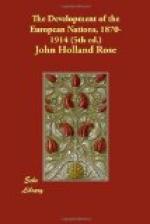No great event took place during the rule of the next Pashas, or Khedives as they were now termed, Abbas I. (1849-54), and Said (1854-63), except that M. de Lesseps, a French engineer, gained the consent of Said in 1856 to the cutting of a ship canal, the northern entrance to which bears the name of that Khedive. Owing to the rivalry of Britain and France over the canal it was not finished until 1869, during the rule of Ismail (1863-79). We may note here that, as the concession was granted to the Suez Canal Company only for ninety-nine years, the canal will become the property of the Egyptian Government in the year 1968.
The opening of the canal placed Egypt once more on one of the greatest highways of the world’s commerce, and promised to bring endless wealth to her ports. That hope has not been fulfilled. The profits have gone almost entirely to the foreign investors, and a certain amount of trade has been withdrawn from the Egyptian railways. Sir John Stokes, speaking in 1887, said he found in Egypt a prevalent impression that the country had been injured by the canal[354].
[Footnote 354: Quoted by D.A. Cameron, Egypt in the Nineteenth Century, p. 242.]
Certainly Egypt was less prosperous after its opening, but probably owing to another and mightier event which occurred at the beginning of Ismail’s rule. This was the American Civil War. The blockade of the Southern States by the federal cruisers cut off from Lancashire and Northern France the supplies of raw cotton which are the life-blood of their industries. Cotton went up in price until even the conservative fellahin of Egypt saw the desirability of growing that strange new shrub—the first instance on record of a change in their tillage that came about without compulsion. So great were the profits reaped by intelligent growers that many fellahin bought Circassian and Abyssinian wives, and established harems in which jewels, perfumes, silks, and mirrors were to be found. In a word, Egypt rioted in its new-found wealth. This may be imagined from the totals of exports, which in three years rose from L4,500,000 to considerably more than L13,000,000[355].
[Footnote 355: Egypt and the Egyptian Question, by Sir D. Mackenzie Wallace (1883), pp. 318-320.]
But then came the end of the American Civil War. Cotton fell to its normal price, and ruin stared Egypt in the face. For not only merchants and fellahin, but also their ruler, had plunged into expenditure, and on the most lavish scale. Nay! Believing that the Suez Canal would bring boundless wealth to his land, Ismail persisted in his palace-building and other forms of oriental extravagance, with the result that in the first twelve years of his reign, that is, by the year 1875, he had spent more than L100,000,000 of public money, of which scarcely one-tenth had been applied to useful ends. The most noteworthy of these last were the Barrage of the Nile in the upper part of the Delta, an irrigation canal in Upper Egypt, the Ibrahimiyeh Canal, and the commencement of the Wady Haifa-Khartum railway. The grandeur of his views may be realised when it is remembered that he ordered this railway to be made of the same gauge as those of South Africa, because “it would save trouble in the end.”




